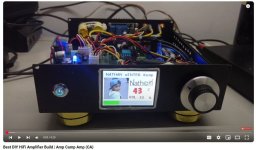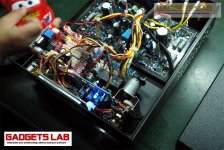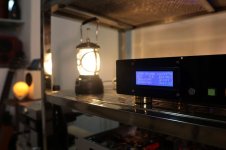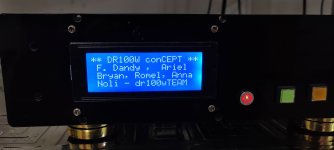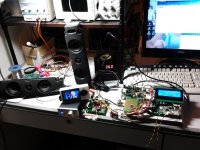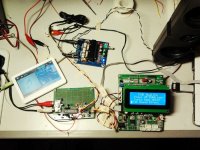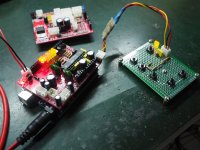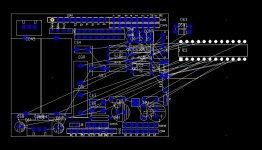It is claimed an Augmented Damping Technology by the Chinese designer which is different from Class A or Class AB. I wanted to know more about this so I posted here to get to know better of the technology, dive in and take a look at it, and play around in a DIY bench test if possible. I learned class-L, heard its performance, interviewed the designer in the past November 2024 Guangzhou High End Show in China. I want to DIY build one.
Last edited:
You know more about it than I do, perhaps you would provide more information...
The designer claimed based on the ambushed interview,
1. newly invented damping technology architecture
2. it can control the speaker diaphragm, de-celeration quickly, it seems that, even the audio signal stopped suddenly but the diaphragm will still continue to vibrate and produce a trailing noise, he stresses that by controlling the speaker will result in a cleaner sound
3. he also mentioned that, it used 5X the power compared to class AB, and class-L is only 20% efficiency
Long story short, it looks like (to me) a servo mechanism to drive the speaker - a better damping control. It is called Class-L because its output characteristic do not belong to the current category of Class A, AB, C D, T, H. The L was taken from the shape of an ancient Chinese musical instrument which looks horizontal L-shape.
I have been trying to get in touch with the designer, but it looks that, this is a trade secret, while there are other info about Class L which is different from what I am know..... confused! I am more into DIY as builder and exploring Amplifier classes, and really interested to get into this Class-L its interesting.
1. newly invented damping technology architecture
2. it can control the speaker diaphragm, de-celeration quickly, it seems that, even the audio signal stopped suddenly but the diaphragm will still continue to vibrate and produce a trailing noise, he stresses that by controlling the speaker will result in a cleaner sound
3. he also mentioned that, it used 5X the power compared to class AB, and class-L is only 20% efficiency
Long story short, it looks like (to me) a servo mechanism to drive the speaker - a better damping control. It is called Class-L because its output characteristic do not belong to the current category of Class A, AB, C D, T, H. The L was taken from the shape of an ancient Chinese musical instrument which looks horizontal L-shape.
I have been trying to get in touch with the designer, but it looks that, this is a trade secret, while there are other info about Class L which is different from what I am know..... confused! I am more into DIY as builder and exploring Amplifier classes, and really interested to get into this Class-L its interesting.
ACA, rename to Nathan Winter KAmp, achieved less heatsink using a digital brain (AMPduino-A3CS) to control the analog heart (ACA) on 18x30x5 cm aluminum casing. I have been demo'ing this in the Manila Mini Maker Faire and also in the Arduino day. I have a video of it,,
1. design philosopy
2. mechanical design revolution
3. the use of digital intelligent controller
4. lots of testing, here and there
5. HMI - Human Machine Interface
6. -- served as inspiration to my fellow DIYer's (in the Philippines)
let me just ask if its OK to share the link.
1. design philosopy
2. mechanical design revolution
3. the use of digital intelligent controller
4. lots of testing, here and there
5. HMI - Human Machine Interface
6. -- served as inspiration to my fellow DIYer's (in the Philippines)
let me just ask if its OK to share the link.
Attachments
Last edited:
Class-D -- I called it DR100W concept project, comes with different boards
1. dr100w-PA, TDA8920BTH / TDA8950TH class d amplifier
2. dr100w-EQ TDA7449 for the tone control, PT2389 preset EQ
3. dr100w-CM controller 8051 uC STC90C516 RD+ program using BASCOM 8051
4. dr100w-PSU SMPS (ready made , +/- 32 Vdd)
5. black fiber glass casing
was mean for learning class d. I dedicated a bunch of videos on YT to teach how this amplifier done specially on the software side -- shareware and courseware!
1. dr100w-PA, TDA8920BTH / TDA8950TH class d amplifier
2. dr100w-EQ TDA7449 for the tone control, PT2389 preset EQ
3. dr100w-CM controller 8051 uC STC90C516 RD+ program using BASCOM 8051
4. dr100w-PSU SMPS (ready made , +/- 32 Vdd)
5. black fiber glass casing
was mean for learning class d. I dedicated a bunch of videos on YT to teach how this amplifier done specially on the software side -- shareware and courseware!
Attachments
Hello, I have this project also name - AMPduino, but its broad application (to me), its in the form factor of Arduino Uno. what I have here is the AMPduino-PeQS, it means Preset EQ based on the PT2389. Other shield were developed and put into action. My overall aim is to create a stackable shield and end up in building a personal musicmate, hence there is also the AMPduino-myMUSICmate.
Attachments
There was a patent about 1978 called ACE bass that was controlling the speaker via frequency dependent feedback and negative impedance. Yamaha bought the patent but didnt have much success with it. The amplifier must be special build for the speaker and its box. With the wrong speaker it could even self oscillate.
But it was very impressive in getting a lot of bass out of a the small box it was made for.
You can test a bit of the effect just by simulating a bass reflex box while subtracting a few ohms resistance from the speaker element. For many drivers it is possible to get the same bass with less than half the box volume. And that is without the frequency dependance.
But it was very impressive in getting a lot of bass out of a the small box it was made for.
You can test a bit of the effect just by simulating a bass reflex box while subtracting a few ohms resistance from the speaker element. For many drivers it is possible to get the same bass with less than half the box volume. And that is without the frequency dependance.
This is not necessary. It is a natural result of the system band limit.2. it can control the speaker diaphragm, de-celeration quickly, it seems that, even the audio signal stopped suddenly but the diaphragm will still continue to vibrate and produce a trailing noise, he stresses that by controlling the speaker will result in a cleaner sound
People have been saying things like this for years.
Amplifiers can be designed to produce a negative output resistance, effectively dropping Qes of the driver. That will improve the damping. Too low of a Q tends to scrub off bass response, though. Boosting it back elsewhere in the chain will add group delay and ringing…… No free lunch.
It has gone about 50 years since i tried negative impedance. and that was in the time before we knew Qes, Qms and other parameters. Just Q and frequency.
I got a decent result with about 3 ohms negative. It damped the sound of the box resonance a bit but if you remember a usual impedance chart of a bass speaker element there is an impedance lift at the bass resonance and in high frequencies.
The higher the impedance is the lower the impact of the negative impedance will be.
At 6 ohms it will double the voltage to the speaker but at 20 ohms it will ony be 20/17.
So the output at the bass resonance and at high frequencies will be lower then the mid bass.
And the speaker element was made for 0 ohm output.
The ACE bass was frequency dependent in its impedance but i was never successfull in trying to calculate that. This was 20 years before i saw the first simulator.
I got a decent result with about 3 ohms negative. It damped the sound of the box resonance a bit but if you remember a usual impedance chart of a bass speaker element there is an impedance lift at the bass resonance and in high frequencies.
The higher the impedance is the lower the impact of the negative impedance will be.
At 6 ohms it will double the voltage to the speaker but at 20 ohms it will ony be 20/17.
So the output at the bass resonance and at high frequencies will be lower then the mid bass.
And the speaker element was made for 0 ohm output.
The ACE bass was frequency dependent in its impedance but i was never successfull in trying to calculate that. This was 20 years before i saw the first simulator.
- Home
- Vendor's Bazaar
- Class L Newly Invented Audio class by ShangTsing
